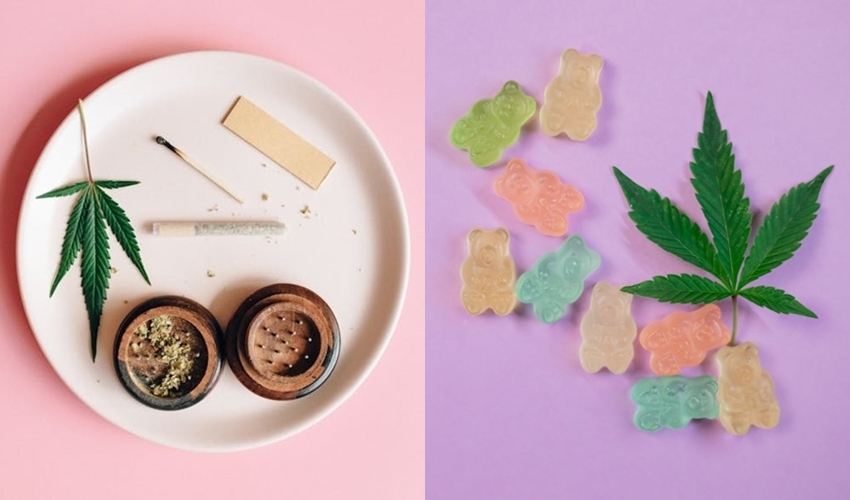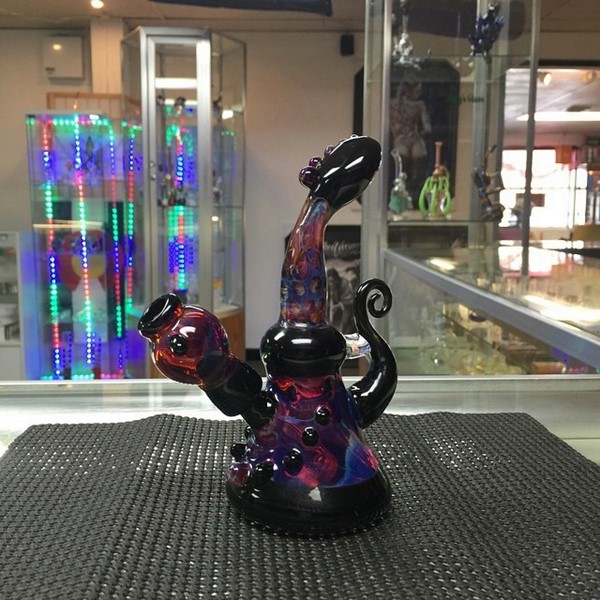To those who have smoked herb for some time, the dab rig will look strangely familiar. It resembles the venerable bong, except that dab rigs are smaller and often feature more elaborate designs. The dab rig resembles the bong because form follows function and the function of the dab rig is the same as that of the bong: to filter (in this case) vapor through water to remove heat and impurities.
Author: Kendall Scheufler
Smoking Cannabis vs. Eating Edibles: How They Compare
More than a few people who visit our smoke shop in Parker assert that the buzz they get from edibles is distinctly different from the one they get from smoking a joint or using a bong. But are they right or is the alleged difference just an urban myth? In fact, there may be something to the claims that edibles and smoking produce two different experiences. But even if we believe that’s true is there any way to prove it? That’s what we at the Smoking Buddha smoke shop are here to find out.
Vape Juice Storage and Expiration Guide
Here at the Smoking Buddha vape shop in Parker, we’ve found that one issue seems to consume an awful lot of attention among vaping aficionados and that is this: Does e-liquid go bad and are there ways to store it that will extend its viability? The answer to both parts of that question is “yes”. For that reason, you’ll want to keep these things in mind when storing vape juice.
First Things First: Can You Vape Expired Vape Juice?
Sure. You can also drink expired milk but we wouldn’t recommend it. Seriously though, it’s not like the day after the vape juice expires it will suddenly go bad and produce a rank experience. But if it’s been a month or more we wouldn’t recommend vaping it unless you’re prepared to accept the consequences. And the longer it is past the expiration date the more foul the experience is likely to be. Also, if the vape juice contains nicotine and you’re using it to try and quit smoking it’s likely the nicotine hit will start to degrade not long after the expiration date passes.
With the above in mind here are some things you can do to help keep your vape juice fresh and tasty.
Don’t leave it sitting in direct sunlight
Without the sun none of us would be here. But while we owe our very existence to the sun our home star is, without a doubt, something of a mixed blessing. When you enter our vape shop you won’t see any vape juice being stored in direct sunlight. That’s because exposing vape juice to direct sunlight is a sure way to accelerate the decay process. The UV rays in the sunlight will work on the ingredients in the vape juice, breaking them down and reducing the flavor and nicotine content.
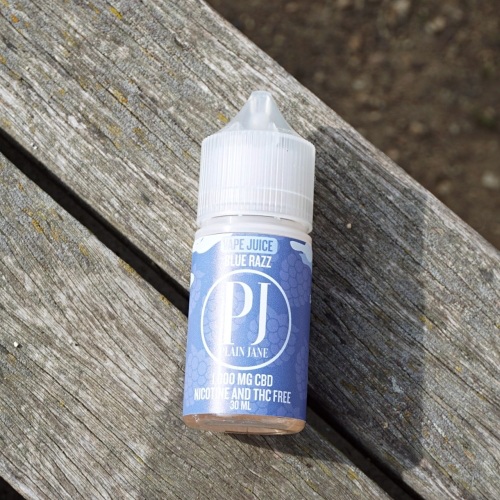
Don’t ignore the expiration date
The expiration date is not like a cliff your vape juice will fall from the next day. It’s more the day the manufacturer washes their hands of responsibility. By that, we mean that if you choose to use the vape juice after the expiration date stamped on the bottle, you’re on your own. As the manufacturer will take no responsibility for the quality of your experience after that date. In our experience at the smoke shop, different vape juices tend to degrade at different speeds. And different batches of the same flavor may even degrade at different rates. Tap here for an explanation of the different kinds of expiration dates.
Make sure you close the bottle after use
Like sunlight, the air we depend on for our existence is also a mixed bag. If you leave your vape juice container open to the air it will invite oxidation. Oxidation will begin to break down some of the ingredients. Over time the flavor will take a significant hit which you will notice immediately should you try to vape some of this oxidized juice. Oxidation will also cause a reduction in the nicotine content of vape juice.

Don’t fall for the freezer trap
A lot of folks think: “I put all kinds of food in the freezer to ensure long-term viability, why not vape juice?” It’s an understandable idea, but there are a couple of problems with it. First of all vape juice does not contain water. Its main ingredients are instead propylene glycol and vegetable glycerin. These compounds have a considerably lower freezing point than water, meaning it’s likely your vape juice will never actually freeze in the freezer. Although it’s likely it will thicken up over time. But that’s not the biggest problem. In time the ingredients in most vape juices will begin to separate. Once that happens the juice is essentially useless.
Don’t expose your vape juice to excessive heat
There are several potential sources of excessive heat you should keep your vape juice clear of. The first is the direct sunlight we mentioned earlier. But that’s not the only one.
You should also avoid leaving your vape juice near a working stove, or inside a car you park for an extended period of time in the sun. Just like you should never leave your dog in a hot car you don’t want to leave your vape juice in one either.

Buy vape juice in glass bottles
It’s not always easy to tell the difference visually between plastic vape juice containers and glass. But there are a few ways you can differentiate them. First, glass will be heavier than plastic. Second, vape juice in a plastic container will usually cost less than plastic. If you picked up the container and checked the price and still can’t decide whether it’s glass or plastic just ask a member of our smoke shop in Parker staff. But why is it important to choose glass? Mainly because plastic is a synthetic material that will begin to degrade over time. This process of degradation can alter the taste of vape juice and may shorten its useful lifespan.
Does Vape Juice Pose a Danger to Kids?
Toddlers want to learn about everything they come in contact with and they often try to learn about them by putting them in their mouth. If they wind up ingesting standard flavored nicotine-free juice they’re likely to ecome nauseous. But if they ingest vape juice with concentrated nicotine in it they may start to vomit and exhibit other troubling signs that something is seriously wrong. To avoid that disturbing possibility, store your vape juice in a cool place where the kids can’t get it. If you believe that a child in your care may have injected ejuice, call poison control immediately or seek urgent medical attention.
How You Can Tell if Your Vape Juice Has Gone Bad
As we mentioned earlier it’s not like the day after the expiration date the vape juice is suddenly going to be worthless. The expiration date is more like the date after which quality will start to degrade, though it will take some time before it becomes a truly unpleasant experience.
Nonetheless, a lot of folks want to know if there is some way they can tell that their vape juice has gone bad. The answer is that in some cases (depending on the flavor and other factors) the vape juice may start to darken in color, as we’ve illustrated in the guide below.
“As vape juice expires, the flavorings and nicotine will start to break down. This can cause the vape juice to taste different, or even to lose its flavor altogether. The nicotine in the vape juice may also become less potent, which can make it less satisfying to vape.”
—Mister Vape
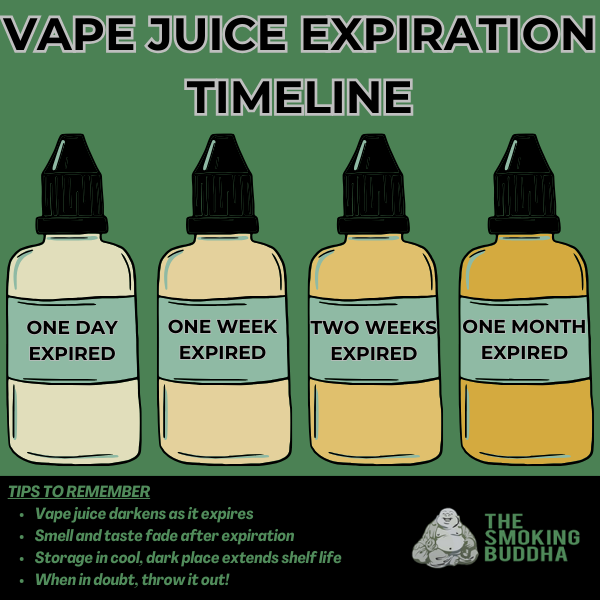 Download a PDF of the Infographic Above:
Download a PDF of the Infographic Above:
It’s also likely that vape juice’s smell will fade as it ages beyond its expiration date. If there are any heavy ingredients in the ejuice, they may eventually begin to separate and settle to the bottom of the ejuice bottle.
Visit the Smoking Buddha Smoke Shop in Parker
If you’re in Parker pay a visit to the Smoking Buddha vape shop where you will find a wide variety of vape juices and a friendly staff that will answer any questions you might have.
Bong Essentials: History, Popular Styles and How to Clean Them
Bongs have become a staple of cannabis culture, offering enthusiasts a smoother, cooler, and often more flavorful smoking experience compared to traditional pipes or joints. As an online smoke shop, it’s essential to not only showcase the wide array of bongs available but also to educate customers about their history, the materials used to craft them, the different styles, and why maintaining a clean bong is crucial for both health and enjoyment. In this article, we’ll take an in-depth look at these elements, providing a comprehensive guide to bongs for both newcomers and seasoned smokers alike.
The History of Bongs

Bongs, or water pipes, have been around for thousands of years, with early versions appearing in regions such as Africa and Asia. The first water pipes were likely crafted from bamboo, clay, or gourds, designed to filter smoke through water for a smoother experience. By the 16th century, China saw the rise of more elaborate water pipes, and their design began resembling some of the intricate shapes we recognize today.
The modern bong, however, emerged in the 1960s and 70s, influenced by the counterculture movement and the growing popularity of glass artistry. During this time, scientific glass became a prominent material for creating durable, high-performance bongs. Today’s bongs come in a wide variety of materials and designs, from sleek, scientific glass to flexible, travel-friendly silicone options, reflecting the diverse tastes of smokers worldwide.
Glass vs. Silicone Bongs
The current bong market primarily offers three types of materials: scientific glass, heady glass, and silicone. Each offers distinct advantages suited to different needs and preferences.
Scientific glass bongs, made from borosilicate glass, are renowned for their durability and resistance to heat. They’re often clear, allowing users to see smoke and water levels. Heady glass bongs, typically hand-blown, are valued for their artistic appeal and are considered collectible pieces. Silicone bongs, crafted from tough silicone, are perfect for those who need a bong that’s portable and nearly indestructible, though some users find they can affect the flavor of the smoke.
| Type | Material & Structure | Features | Pros | Cons |
|---|---|---|---|---|
| Scientific Glass | High-quality, heat-resistant borosilicate glass | Simple, transparent designs | Highly durable, easy to clean, pure flavor | Vulnerable to breakage if dropped |
| Heady Glass | Artistic, often hand-blown glass with unique designs | Visually striking, custom pieces | Collectible, visually pleasing, excellent smoke taste | Typically higher price range |
| Silicone | Flexible, food-grade silicone | Portable, unbreakable | Extremely durable, easy to travel with, cost-effective | Can slightly alter the flavor of smoke |
Popular Bong Styles
There are many different bong styles, each designed to improve the smoking experience in various ways. Here are some of the most popular types:
- Straight Tube Bongs: A classic design, straight tube bongs are straightforward to use and clean. They deliver a quick, direct hit, making them ideal for beginners.
- Beaker Bongs: Shaped like a laboratory beaker, these bongs offer more stability and a larger water capacity, helping to smooth out hits for a better experience.
- Percolator Bongs: These feature one or more percolators that further filter smoke through additional water or bubbles. This extra filtration cools and smooths the hit, with various percolator styles offering different effects. They’re especially favored by seasoned users.
- Recycler Bongs: Featuring a loop system that recycles smoke through water multiple times, these bongs provide superior filtration and cooling, resulting in an ultra-smooth hit.
These bong styles differ in design, yet they all aim to elevate your smoking experience. Whether you’re after portability, simplicity, or ultimate filtration, there’s a bong to suit your needs.
The Importance of Cleaning Your Bong
Regular cleaning is crucial to keeping your bong in good condition and ensuring a clean, enjoyable smoke. Over time, smoke residue, tar, and bacteria can build up, affecting both the taste of the smoke and your health. Dirty bongs can cause unpleasant odors and even contribute to respiratory issues, making it essential to clean your bong regularly.
How to Clean Your Bong
Cleaning your bong is a simple process if you follow the steps outlined below:
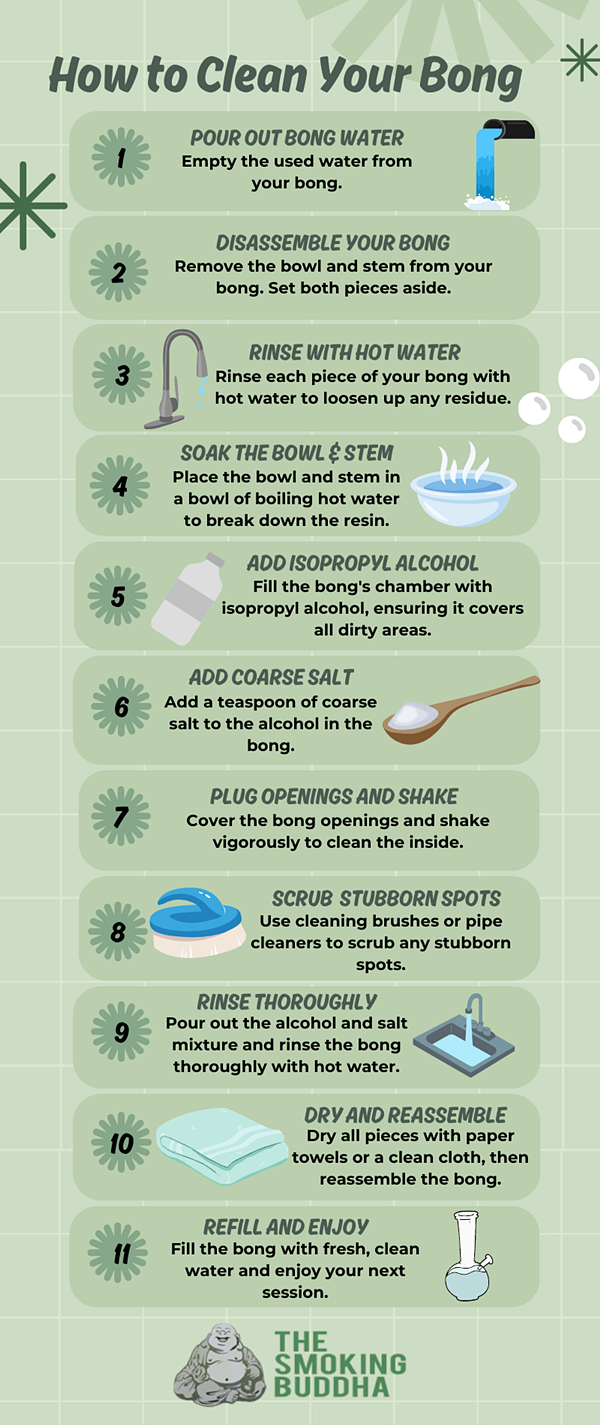 Download a PDF of the Infographic Above:
Download a PDF of the Infographic Above:
Ready to Buy a New Bong?
At The Smoking Buddha, we offer a broad selection of high-quality bongs, including scientific glass, artistic heady glass, and flexible silicone models. Whether you’re after a top-notch piece for yourself or looking to buy in bulk for your shop, we have something for everyone. Explore our collection today and find the perfect bong for your needs!
Vape Juice Guide: Types, Flavors and FAQs
Whether you’re new to vaping or an experienced enthusiast, understanding vape juice options can elevate your experience and ensure you’re getting the best out of every puff. From the basics of what vape juice is to the science behind PG and VG ratios, this guide covers everything you need to know to make an informed choice when selecting e-liquids.
Cannabis Grinder Guide: FAQs, Types and Tips for Better Use
If you’re tired of cleaning the sticky residue from your hands after hand-grinding your weed and you have decided to look into a grinder, read on. Below, the staff at The Smoking Buddha smoke shop answer the most common questions we get about grinders and grinding.


